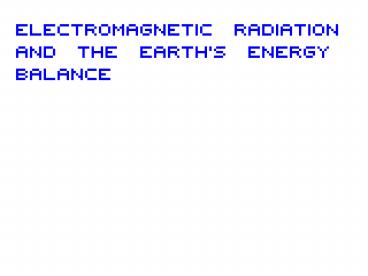Electromagnetic Radiation and the Earths Energy Balance - PowerPoint PPT Presentation
1 / 35
Title:
Electromagnetic Radiation and the Earths Energy Balance
Description:
Objects radiate energy based on their temperature. Higher temperature higher energy ... Waveparticle duality of light. Light absorption leads to excitation of: ... – PowerPoint PPT presentation
Number of Views:115
Avg rating:3.0/5.0
Title: Electromagnetic Radiation and the Earths Energy Balance
1
Electromagnetic Radiation and the Earths Energy
Balance
2
Electromagnetic Spectrum
Energy increases this way
Wavelength increases this way
3
Blackbody Radiation
- Objects radiate energy based on their
temperature - Higher temperature ? higher energy radiation
(Wiens Law) - Higher temperature ? higher intensity radiation
4
Blackbody Radiation
5
Blackbody Radiation
T 5800 K
T 288 K
6
Solar Emission Flux
The sun emits about 6.3 X 107 W/m2 of radiant
energy
7
Solar Emission Flux (the view from Earth)
Sun
Earth
d 1.5 x 108 km
S0 1370 W/m2
L0 3.9 x 1026 W
Amount of radiation from sun reaching the top of
the Earths atmosphere per second
S0 L0/(4pd2)
not to scale
8
Solar Energy (the view from Earth)
Ruddiman, 2001
Actual amount absorbed at the surface is
lower due to the Earths Albedo
9
The Earths Albedo
Albedo is the percentage of the sunlight that is
reflected back to space
Global Average (0.31)
Adapted from Wikibooks
10
The Earths Albedo
From NASA Earth Observatory
11
The Earths Albedo
TOMS image
12
The Earths Radiation Balance
13
The Earth has an atmosphere and it absorbs some
SW and lots of LW radiation! (for now we wont
worry about whats doing the absorbing)
At the surface (i.e. looking up)
At the TOA (i.e. looking down)
This figure was prepared by Robert A. Rohde for
the Global Warming Art project.
14
Earth, Mars and Venus
T (S0(1-A)/4s)0.25
15
The Greenhouse Effect A simple model
16
The Greenhouse Effect A simple model
S0/4(1-A)
Slab Atmosphere
Based on Hartmann, Global Physical Climatology
17
How can we improve this model?
18
The Greenhouse Effect A simple model
(1-l)Ts4
S0/4(1-A)
lTa4
Slab Atmosphere
lTs4
lTa4
l emissivity
Based on Hartmann, Global Physical Climatology
19
The Greenhouse Effect Two-slab model
S0/4(1-A)
Based on Hartmann, Global Physical Climatology
20
Global Energy Balance
Hartmann, 1994
The atmosphere is neither 100 transparent or
opaque
21
Global Energy Distribution
Actual energy distribution depends on
- Time of day (longitude)
- Day of year (latitude)
22
Solar Zenith Angle
- Declination Angle (d) latitude of point directly
under the sun at noon - - varies from 23.45 (June 21)
- to -23.45 (Dec. 21)
2. Hour Angle (h) longitude of point relative to
noon
3. Latitude (f)
23
Solar Insolation
Daily Average
Annual Average
Average daily insolation varies w/ season
Figures from Hartmann, 1994
24
Global Energy Balance
From Meteorolgy Understanding the Atmosphere
The global mean temperature profile is not in
radiative equilibrium but radiative-convective
equilibrium
25
What Makes a Good Greenhouse Gas?
Abundance Absorption cross-section (how
strong) Absorption frequency/wavelength
(where) Atmospheric lifetime Spatial distribution
26
Spectroscopy
27
Plancks Law for Blackbody Radiation
or
Stefan-Boltzmann Law derives from Plancks Law
28
Spectroscopy
Absorption of light is selective
A given molecule will only absorb/emit light with
particular wavelengths This is a consequence of
the quantum nature of light and
molecules Wave\particle duality of light
Light absorption leads to excitation of
Electronic (lt1 mm, UV and Visible) Vibrational (lt
20 mm, Near Infrared and Infrared) Rotational (gt
20 mm, Far Infrared) Translational (not quantized
or directly excited)
29
Spectroscopy
Molecules can only be vibrationally or
rotationally excited if they have a permanent or
temporary dipole moment
This is why H2O, CO2 and O3 are IR active while
N2 and O2 are not
Physics World, 2003
30
This figure was prepared by Robert A. Rohde for
the Global Warming Art project.
31
CO2, H2O, CH4, N2O and O3 are all IR-active
Why are CO2 and H2O such great GHGs while CH4,
O3 and N2O are not?
32
Line Broadening
Absorption of light is selective
Wavenumber 1/wavelength
5.2 mm
33
Line Broadening
Absorption of light is selective
34
Line Broadening
Doppler Broadening
Results from movement of molecules relative to
the direction of propagation of a photon
Pressure Broadening
Results from collisions with other molecules
(this is where N2 and O2 come in)
35
Line Broadening
Pressure Broadening
Pressure
Doppler
Goody and Yung, 1989























![L 18 Thermodynamics [3] PowerPoint PPT Presentation](https://s3.amazonaws.com/images.powershow.com/6877662.th0.jpg?_=20150709116)







